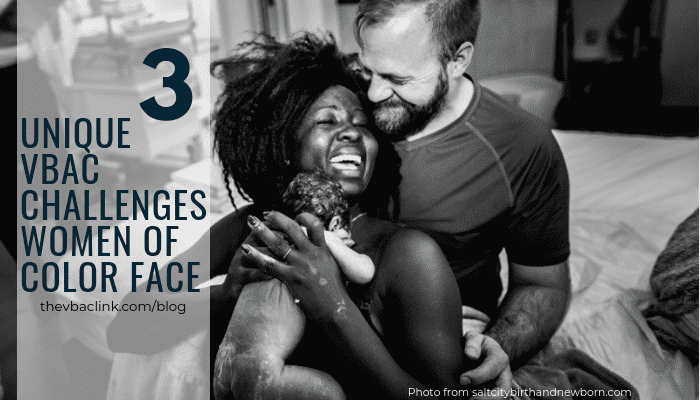Before we get into this, I want to explain something. This topic might seem a little awkward or uncomfortable coming from two white girls from predominantly white Utah.
What could we possibly know about racism and how it effects birth women? You might be surprised to know that we, as doulas, have encountered racism directed towards our laboring clients.
In addition to that, as we keep digging into VBAC and the issues surrounding it, the more we learn about the unique challenges that face women of color.
So, let it be uncomfortable, because it is the discomfort that sparks a reason for change.
Here, we explore three big challenges unique to women of color and VBAC.

(We LOVE this image from our friend Rowan at Salt City Birth and Newborn. This is NOT a VBAC parent. You can find the whole birth video here.)
1. The VBAC Calculator is Biased Against Race
The VBAC Calculator is a collection of data from 7,600 women who had a TOLAC. It calculates any particular woman’s chance of success against that data.
There are several data points used for the calculation including maternal age, BMI, the reason for past C-section, if there has ever been a vaginal delivery before and/or after the C-section, and race. Yep, Race.
Being African American or Hispanic decreases your chances a LOT. Go ahead and play around with it here. Enter your information and then check and uncheck the boxes asking about race and refresh to get an updated calculation.
When I put my information in and adjust only the race options it drops my predicted chances by 19%, and I have already had three VBACs.
The unfortunate thing is that a lot of providers will not support VBAC if your predicted success rate is less than 70%. That pretty much rules our most Women of Color for VBAC (really, you NEED to play around with the VBAC calculator).
The good thing is, ACOG states that a predicted success rate of less than 70% is not a contraindication for TOLAC.
My very first VBAC client, who just happened to be Hispanic, had a predicted success rate of just 4%, yes FOUR. She pushed her baby out in 20 minutes. Take that VBAC calculator.
2. Women of Color are Significantly More Likely to Have a Cesarean Birth and Even Die During Childbirth
Racism during childbirth is not limited to just VBAC. Women of Color are twice as likely to have Cesarean births and are 3-4 times more likely to die during childbirth. These numbers hold true despite education level, income level, or socioeconomic status.
This. Is. Not. OK.
I had a client early this year whose first language was Spanish, she was born in Mexico, as was her husband. They both understood and spoke English very well, which is good because my Spanish is limited to “Hola, Como Estas? uhhhh… No…”
When we got to the hospital the nurse, a white woman, mid to late 50’s, would only speak to her in a slow and loud tone asking questions followed by “Do you know what that means?”
Like she was a Kindergartner leaning about birth procedures for the first time.
However, that was even much better than when she started using broken Spanish to try to talk to my client so that I couldn’t understand what she was telling them.
Sadly, this was one of my most educated and intuitive clients.
She was judged immediately by the color of her skin and her accent and, as the birth went on and some unexpected things happened, all the L&D and even postpartum staff were very vocal on blaming this Mother for “endangering her baby” and for “listening to her doulas medical advice” when I never offered medical advice.
Assumptions were made. Incredibly incorrect assumptions took a heavy toll on this mother’s heart all due to her race.
3. Women of Color Are Significantly Less Likely to Have a Successful VBAC
In an analysis of over 100,000 births, this study shows that white, non-Hispanic women are almost 10% more likely to have a successful VBAC than black, non-Hispanic women.
Again, these outcomes are despite education level, income level, or socioeconomic status. Sadly, these numbers are pretty similar among various studies and time frames for the last 20 years.
Women of color in the Southern parts of the United States have the highest chances of Cesarean birth and lowest chances of VBAC while women in the Northeast see less of a racial disparity.
Some Ways to Help
Head over to Black Mamas Matter to find out more about Black Maternal Health Week in April. This group has even more resources and ways you can support the movement to decrease the racial disparity in the birth space.
Learn more and hear more stories! Black Women Do VBAC is a great site full of more information, studies, and stories of Women of Color who have had VBACs. The more you know, the more you realize that something needs to change!
Check out episode 49 of our podcast to hear Schermisia’s VBAC story and helpful tips for Women of Color.
Want to go out there and make a difference for VBAC moms? Become a doula!
Our Advanced VBAC Doula Certification course is the most comprehensive out there, with everything you need to get certified and start guiding mothers through their VBAC experiences.
Register today, and start your doula journey!













 How to Turn Prodormal Labor into Active Labor
How to Turn Prodormal Labor into Active Labor